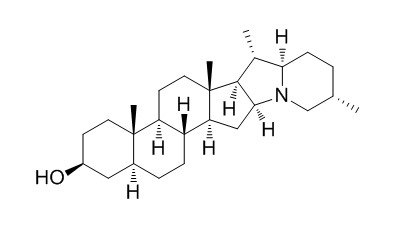Demissidine
Demissidine can induce programmed cell death.
Inquire / Order:
manager@chemfaces.com
Technical Inquiries:
service@chemfaces.com
Tel:
+86-27-84237783
Fax:
+86-27-84254680
Address:
1 Building, No. 83, CheCheng Rd., Wuhan Economic and Technological Development Zone, Wuhan, Hubei 430056, PRC
Providing storage is as stated on the product vial and the vial is kept tightly sealed, the product can be stored for up to
24 months(2-8C).
Wherever possible, you should prepare and use solutions on the same day. However, if you need to make up stock solutions in advance, we recommend that you store the solution as aliquots in tightly sealed vials at -20C. Generally, these will be useable for up to two weeks. Before use, and prior to opening the vial we recommend that you allow your product to equilibrate to room temperature for at least 1 hour.
Need more advice on solubility, usage and handling? Please email to: service@chemfaces.com
The packaging of the product may have turned upside down during transportation, resulting in the natural compounds adhering to the neck or cap of the vial. take the vial out of its packaging and gently shake to let the compounds fall to the bottom of the vial. for liquid products, centrifuge at 200-500 RPM to gather the liquid at the bottom of the vial. try to avoid loss or contamination during handling.
J Food Biochem.2019, 43(9):e12970
ACS Chem Biol.2019, 14(5):873-881
J of Liquid Chromatography & Related Technologies2024, 47(1-5):14-25.
Int J Mol Sci.2021, 22(10):5181.
Molecular Simulation2023, 49(8):799-815.
Molecules.2021, 26(8):2161.
Hong Kong Baptist University2023, 048330T.
Tumour Biol.2015, 36(9):7027-34
Cosmetics2021, 8(3),91.
Toxicol In Vitro.2018, 52:94-105
Related and Featured Products
Molecules 2008, 13(10):2462-2473.
Alkaloids Induce Programmed Cell Death in Bloodstream Forms of Trypanosomes (Trypanosoma b. brucei).[Reference:
WebLink]
The potential induction of a programmed cell death (PCD) in Trypanosoma b. brucei by 55 alkaloids of the quinoline, quinolizidine, isoquinoline, indole, terpene, tropane, steroid, and piperidine type was studied by measuring DNA fragmentation and changes in mitochondrial membrane potential.
METHODS AND RESULTS:
For comparison, the induction of apoptosis by the same alkaloids in human leukemia cells (Jurkat APO-S) was tested. Several alkaloids of the isoquinoline, quinoline, indole and steroidal type (berberine, chelerythrine, emetine, sanguinarine, quinine, ajmalicine, ergotamine, harmine, vinblastine, vincristine, colchicine, chaconine, Demissidine and veratridine) induced programmed cell death, whereas quinolizidine, tropane, terpene and piperidine alkaloids were mostly inactive. Effective PCD induction (EC50 below 10 µM) was caused in T. brucei by chelerythrine, emetine, sanguinarine, and chaconine.
CONCLUSIONS:
The active alkaloids can be characterized by their general property to inhibit protein biosynthesis, to intercalate DNA, to disturb membrane fluidity or to inhibit microtubule formation.
Pharmaceutical biology, 2009, 47(3):255-259.
Biological activities of steroidal alkaloids isolated from Solanum leucocarpum.[Reference:
WebLink]
The alkaloids Demissidine, dihydrosolacongestidine, solasodine and tomatidine were isolated and identified by spectroscopic methods and by comparison with literature data, from the aerial part of Solanum leucocarpum Dunal (Solanaceae) collected at the Regional Natural Park Ucumarí (Colombia).
METHODS AND RESULTS:
In order to examine topoisomerase I and II activities, the four isolated alkaloids were tested through a mechanism-based bioassay utilizing genetically engineered mutants of yeast Saccharomyces cerevisiae strains RS322N, R52Y and RS321. Dihydrosolacongestidine showed selective activity towards RS321 (249.8 μg/mL) strain rather than RS322N (1542.7 μg/mL), most probably indicating activity through inhibition of DNA topoisomerase II. In the same manner, tomatidine displayed activity through DNA topoisomerase II inhibition. Furthermore, solasodine showed DNA-damaging activity. In addition, the same isolated alkaloids were tested for antibacterial activity by using the agar well diffusion method.
CONCLUSIONS:
Solasodine and dihydrosolacongestidine showed MIC values of 62.5 and 125 μg/mL against Staphylococcus aureus, respectively.
The isolation of these alkaloids and their biological activities are reported here for the first time for S. leucocarpum.



